This Spanish Company Makes the Best Jamón in the World. We Took a 3-Day Tour to Find Out How.

I’m standing eye to eye with a pig in the rugged woodlands of southwest Spain ready to see exactly how the sausage—or Iberian ham, in this case—is made.
Cinco Jotas, one of the country’s oldest and most respected producers of jamón ibérico, recently invited me to Jabugo for a deep dive into the Spanish delicacy. Located a couple hours’ drive from Seville, the mountain village is surrounded by forested meadows (or dehesas) in which Iberian pigs freely roam and is also home to the company’s centuries-old curing cellars (a.k.a. bodegas). Cinco Jotas, nicknamed 5J or Five Jacks, now offers tailored itineraries that allow you to explore and engorge. You can take a private horseback tour of a dehesa, for instance, or learn the ways of the master carver before a private tasting. Each experience (price upon request) is designed to elucidate the intricacies of this gastronomic icon in a delicious fashion.
More from Robb Report
The World's Best New Iconic Fine Wines--From Non-Iconic Fine Wine Regions
This Shuttered Spanish Restaurant Was Once the Best in the World. Now It's Reopening as a Museum.
Nicole Kidman Once Stayed in This Stunning Mallorca Villa. Now It Can Be Yours for $69 Million.
As you may well know, it’s easy to pig out in this part of Spain. Andalusia has a warm Mediterranean climate that is conducive to growing produce and raising livestock. The region has a competitive food scene, too, with 21 restaurants holding one Michelin star or more. My home base for the three-day trip is the small but smart EME Catedral Mercer in Seville (roughly $200 per night). The first night, I hit up the one-starred Abantal for a 12-course dinner (about $185 with matching wines) and enjoy a sumptuous suckling pig dish that is a perfect prelude to tomorrow’s pork.
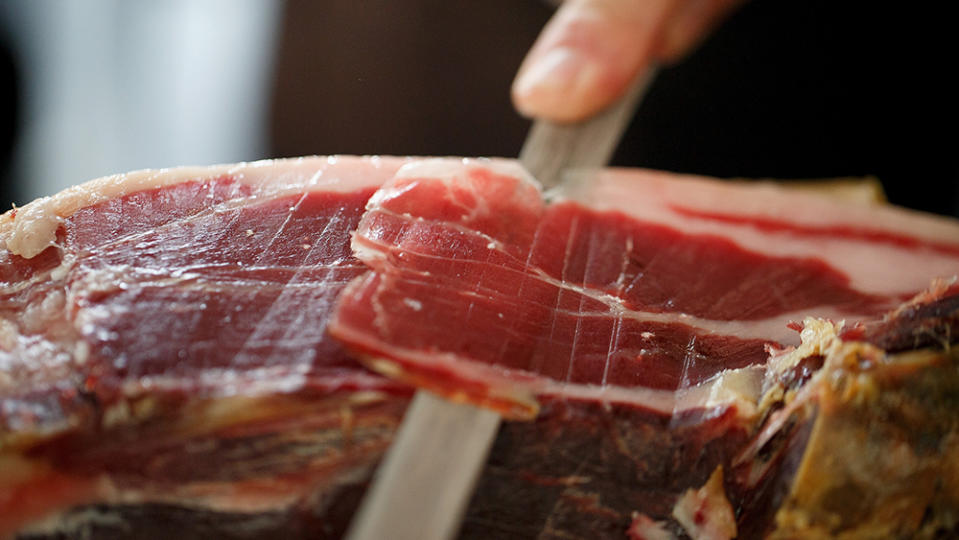
I head to the rolling hills of Jabugo first thing to learn about the Rolls-Royce of ham. The world of jamón ibérico is a large and complex one. Thousands of legs of ham are exported each year to gourmands and restaurants across the globe at a cost of up to $200 per pound, and everything from the pedigree of the pig to the food that it eats can affect the final product. Fortunately, the Spanish government introduced a color-coded classification system in 2014 to make it easier for consumers to discern the caliber of any given leg. (The coveted black label is reserved for purebred, acorn-fed Iberian pigs that were raised free range, while red, green, and white tags denote mixed-breed pigs that were fed acorns, grass, or cereals in smaller enclosers.)
Cinco Jotas has not only been awarded the highest grade possible, but it exceeds even the black label’s standards. For starters, 5J exclusively breeds 100 percent Iberian pigs. Distinguished by black hooves (or pata negra), this breed is a descendant of the Mediterranean wild boar and is indigenous to the Iberian Peninsula that Spain and Portugal share. The black pig is the anthesis of the white pig that is primarily used to make jamón serrano. They have smaller litters, yield less meat per head, and mature far more slowly. Black pigs hold fat differently, too; with much of it marbled throughout the muscle not unlike Wagyu beef. This is what gives the Iberian ham that melt-in-the-mouth texture.
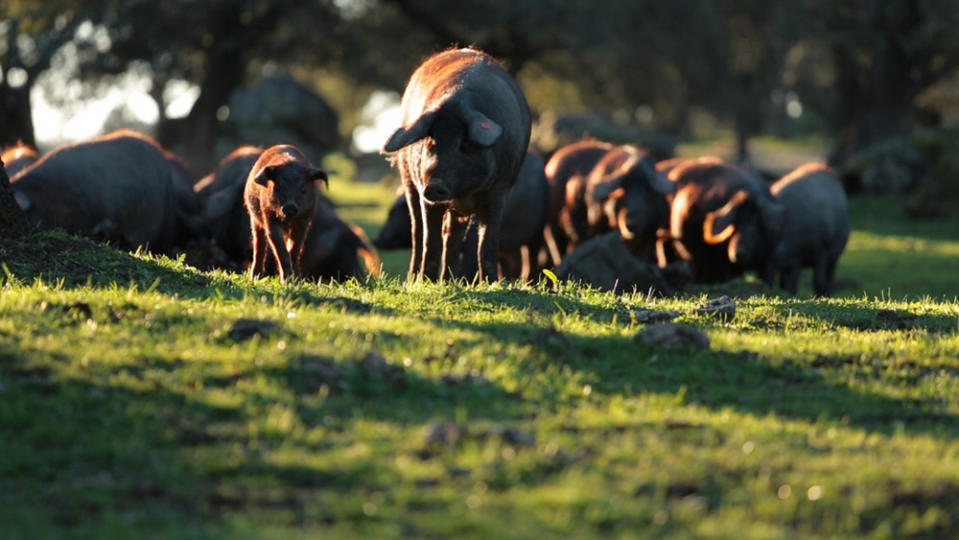
I’m surprised by how sleek and athletic the 20 or so pigs trotting around the dehesa are, but also by how well they are treated from birth to slaughter to thereafter. Cinco Jotas gives each pig five acres of space, even though the black-label designation requires only two acres per pig. To achieve this, the company works with a number of smallholdings located in Jabugo’s UNESCO-protected nature park, which is so picturesque it puts that iconic Windows XP wallpaper to shame. The farmers let the droves freely forage for acorns, grass, and wild herbs, with each pig walking nearly nine miles a day. (You don’t have to cover that distance on the tour, don’t worry.)
The acorns (or bellota), which fall from the plentiful oak and cork trees, give the ham that nutty flavor and a surprising number of health benefits. As acorns are rich in oleic acid, so too is the ham. This healthy fat, which is also found in olive oil, helps to increase our good cholesterol (HDL) and reduce the bad one (LDL). In fact, a 2018 study showed that regularly eating a moderate amount of 5J’s ham has a favorable impact on cholesterol without affecting blood pressure or weight.
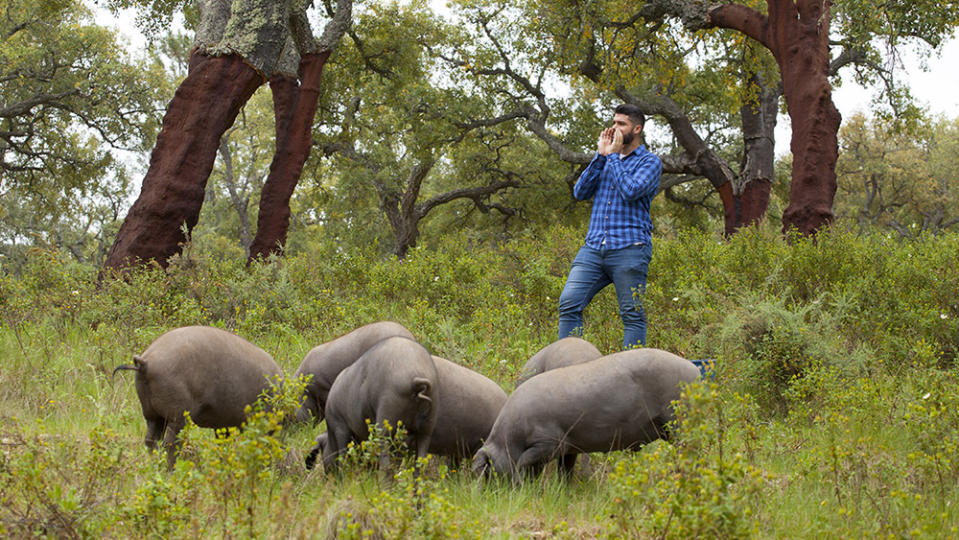
Next up, curing: I head to the cellars and see that Cinco Jotas is just as meticulous when it comes to this part of the process. The artisan traditions have been handed down from generation to generation for the past 130 years and the majority of work is still carried out by hand. The bodegas, which date back to 1879, feature thick brick walls and strategically placed windows that let in just the right amount of mountain air to dry the ham. It’s the polar opposite of a modern-day butcher’s shop, with no air-conditioning or modern machinery in sight. The temperature and humidity are instead controlled simply by opening a window here or splashing a little water there. It helps that the cellars sit high above the Atlantic Ocean and Jabugo provides the ideal weather for curing. No part of the pig is wasted, either: Legs, loins, and shoulders are cured, while the leftover pork is sold to local restaurants.
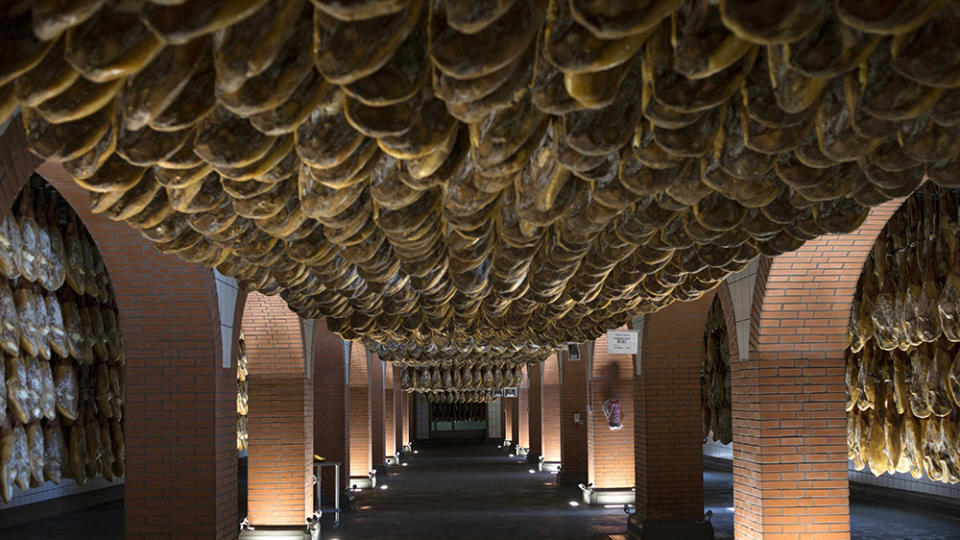
The painstaking curing process begins with the master profiler removing any excess fat from the leg, before curing it in salt for a couple of days (one day per kilogram). The leg is then rinsed and hung to dry in the vast, subterranean cellar for three, four, or even five years depending on weight. During that time, cellar masters care for each individual piece. The legs are regularly rubbed down with oil to protect them from bugs and shifted from hook to hook to ensure they dry properly. Seeing thousands suspended from the ceiling is certainly something to behold; it’s kind of like an art installation that comes with a mouthwatering aroma.
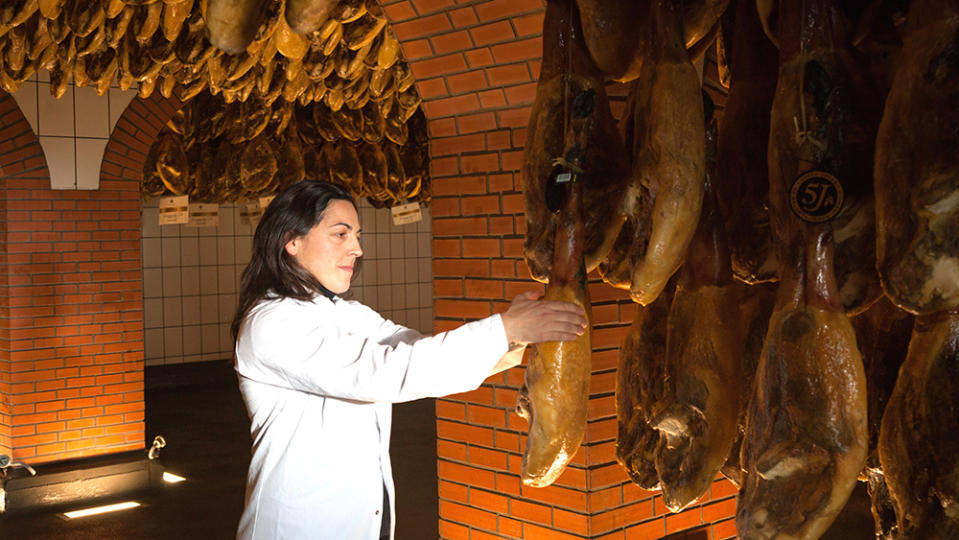
Another highlight is watching a calador sniff each piece to see if it’s up to snuff. There are just eight noses in the cellars entrusted with this important task. Using a small tool called a cala, the master sniffer pierces the ham in four places, then takes a whiff to see if there is the right mix of sweet, earthy, fermented, and floral aromas. You’ll also be given a go to see if you have the makings of a ham sommelier.
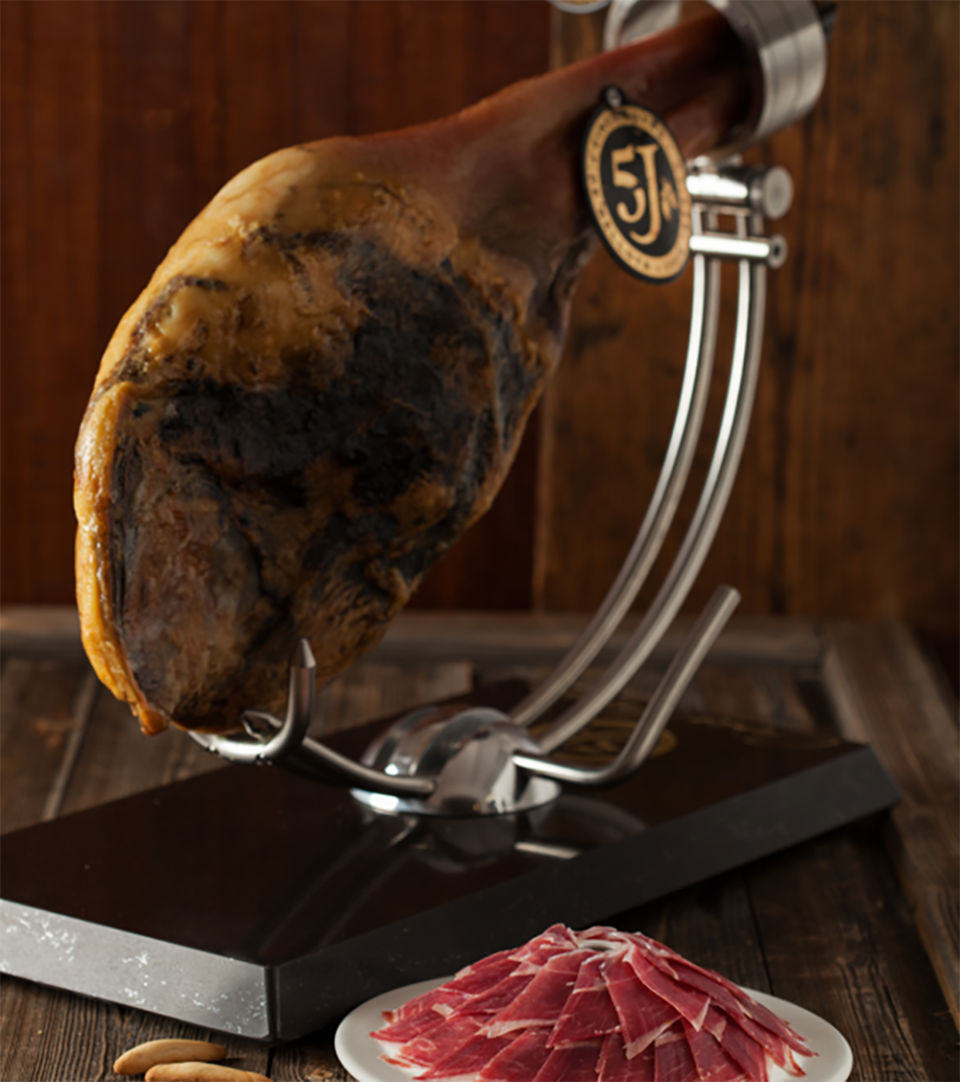
This extravagant display is bested only by a private tasting in the swanky upstairs area. The ham is so soft and delicate that it can only be carved by yet another specialist in what is a show of true precision. The cortador places the leg in a special holder and uses a long knife (the cuchillo jamonero) to create paper-thin slices. I’m a fan of a piece near the hoof called punta—it packs the most amount of fat and salt, of course—but there are parts to appeal to all palates. The slices melt on the tongue almost instantly, then release a sweet nuttiness and a good hit of umami. You’ll get to try the loin and shoulder, too. The nuances of the ham are much easier to appreciate after you see how it evolves from the dehesas to the table. (If you can’t make it to Spain, a bone-in leg of Cinco Jotas will run you about $1,500 and a boneless ham will cost you $1,400.)
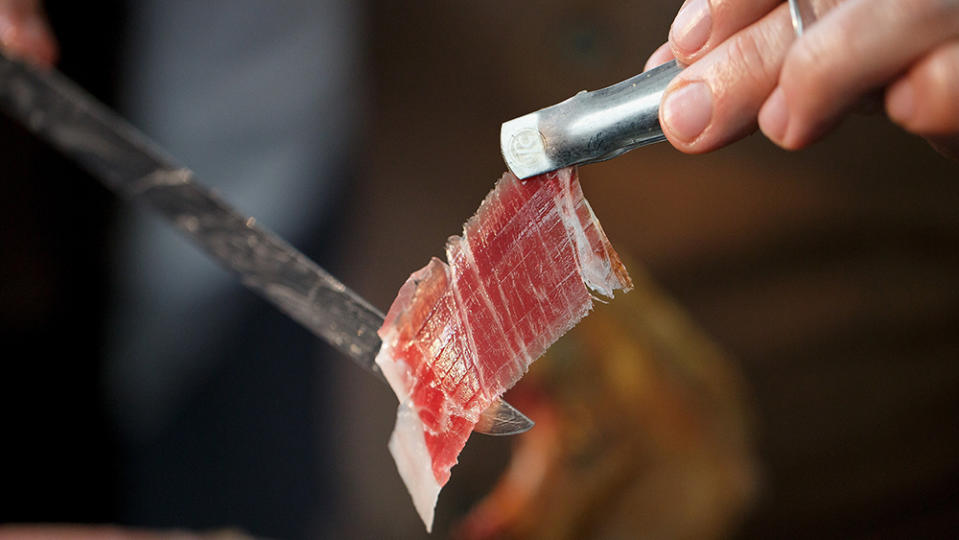
The Osborne sherry that is served at the tasting makes the full-circle moment all the sweeter. The Osborne group, which is basically the Spanish version of LVMH, helms more than 70 luxury brands that run the gamut from Carlos I brandy to Ampersand gin. The family-owned outfit started off making sherries in the early 1800s but expanded beyond fine wines and spirits into gourmet food with the acquisition of Cinco Jotas in 1983. CEO Fernando Terry Osborne tells me he is eager to grow this area and recently added Caviar Riofrío to the portfolio. (It’s billed as the first certified organic caviar in the world.) After a morning of sherry and ham, I have a silky tomato soup at local favorite Arrieros for lunch, before enjoying a plate of scrambled eggs and clams (it works, trust me) for dinner at the buzzy Eslava.
On the third and final day, I hit up Osborne’s bodegas in El Puerto de Santa María. The cellars hold a formidable collection of V.O.R.S (Very Old Rare Sherry). The private visits (about $200 per person) allow you to sample the best wines of the Jerez region with a side of Cinco Jotas ham, naturally. If you ask nicely, you might even be able to convince head winemaker Marcos Alguacil to give you a taste of a decades-old Pedro Ximénez straight from the barrel.
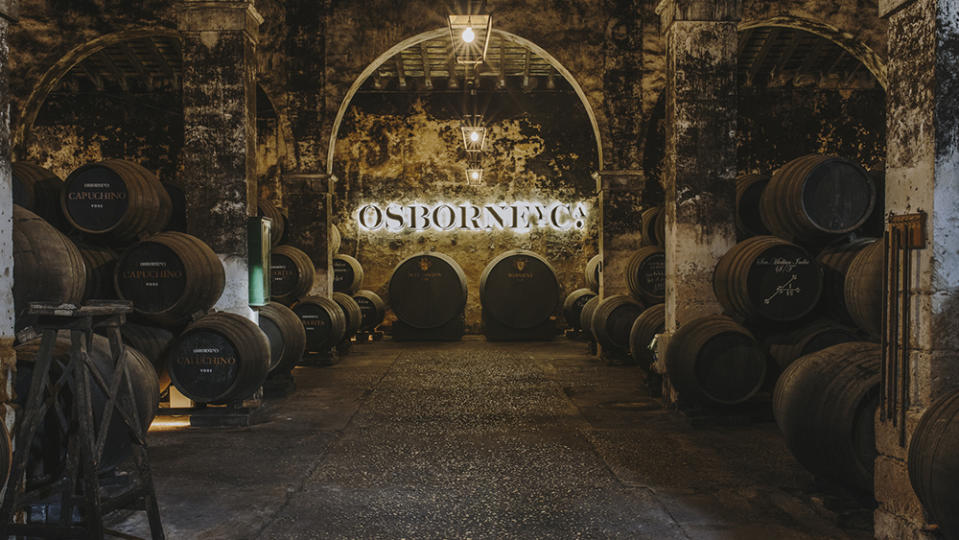
I squeeze in one last multi-course feast at LÚ and unwittingly save the best for last. To me, the relaxed yet refined one-star joint is the pinnacle of Andalusian gastronomy. Chef Juanlu Fernández serves up the culinary jewels of the terroir in a modern, playful way yet still honors the simplicity of the cuisine. You can expect cured Iberian sausage and some Osborne sherry, of course.
All that is to say, Cinco Jotas really is just the cherry—or jamón, rather—on top of southwest Spain.
Best of Robb Report
Why a Heritage Turkey Is the Best Thanksgiving Bird—and How to Get One
The 10 Best Wines to Pair With Steak, From Cabernet to Malbec
Sign up for Robb Report's Newsletter. For the latest news, follow us on Facebook, Twitter, and Instagram.

